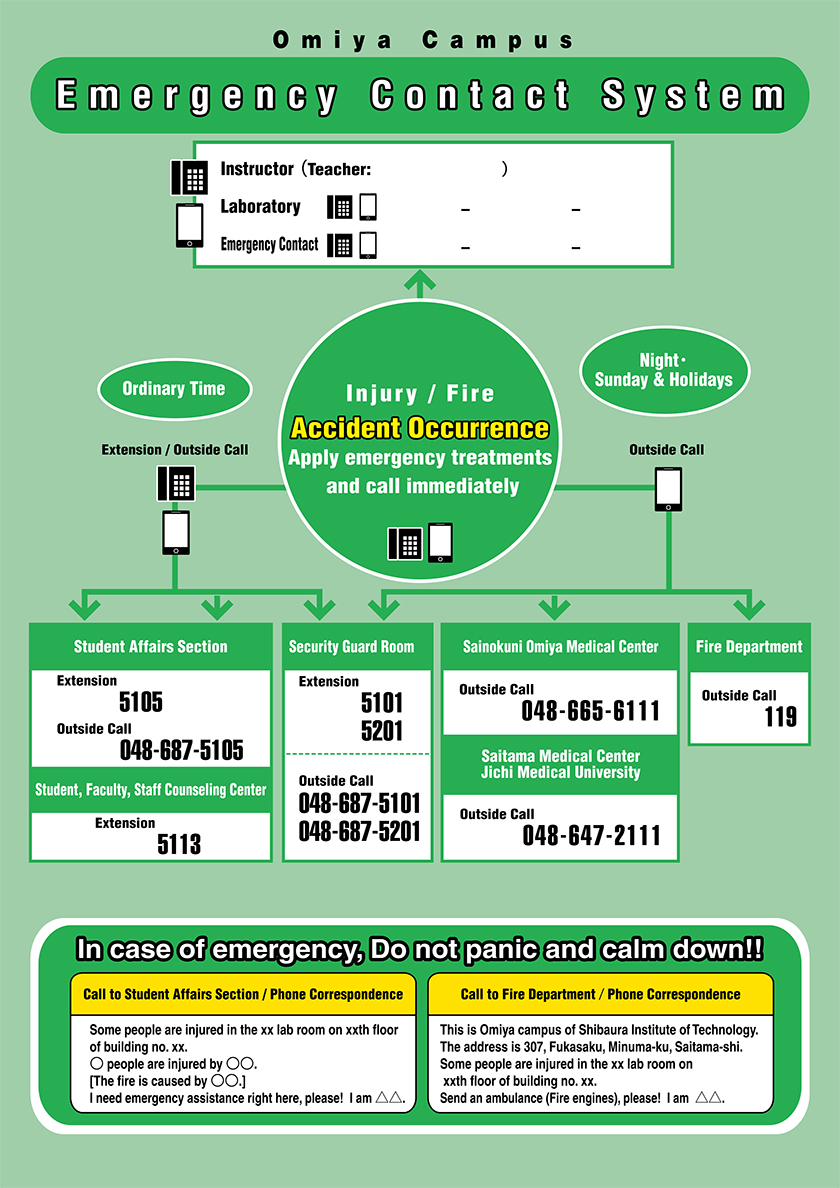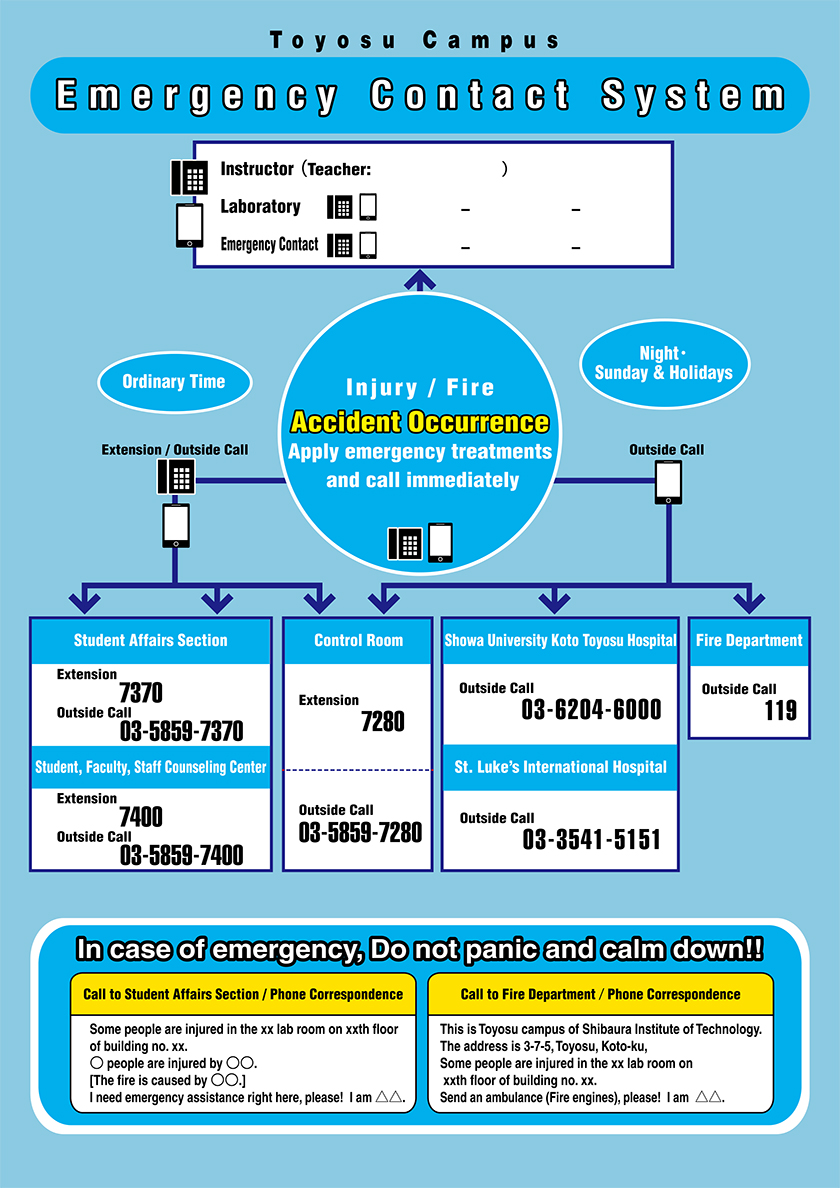Guidance of Safety
Guidance of Safety
1.Safety Basics
1-1 Using this Guide1-2 Fire
1-2-1 Fire Prevention1-2-2 Fire Extinguisher
1-2-3 How to Use Fire Extinguishers
1-2-4 Initial Response to Fire
1-2-5 How to Treat Fire Injurses
1-2-6 When an Explosion Occurs
1-3 Earthquakes
1-3-1 Knowledge and Preparation for Earthquakes1-3-2 What is an ‘Alert Declaration’
1-3-3 Dealing with an Earthquake
1-3-4 Evacuation and communication
1-3-5 Designated Evacuation Areas in Case of Disaster
1-4 First Aid
1-4-1 General Injury Precautions1-4-2 First Aid Measures for Accidents
1-4-3 Trauma・Sprain・Fracture Treatment
1-4-4 Treatment of burns, frostbite, electric shock
1-4-5 First Aid for Gas Poisoning
1-4-6 Treatment of Chemical Injuries
1-4-7 Utilizing the Student/Faculty/Staff Health Counseling Room (Nursing Room)
1-5 Work environment
1-5-1 General Principles1-5-2 Hygiene Standards for Work Environments
1-5-3 VDT Operation
1-6 Contact, Notification, and Warning systems
1-6-1 Contact at night and holidays1-6-2 Overnight Experiments / Reporting on Holiday Entry
1-6-3 Insurance System for Students
1-6-4 Insurance Procedures
2.Safety in specialized fields
2-1 Experiment Safely
2-1-1 Staying Alert to Danger2-1-2 Clothes and Footwear
2-1-3 Safe Working Posture
2-1-4 Tidiness / Organization / Cleanliness / Cleaning
2-1-5 Water Accidents
2-2 Electricity
2-2-1 Basic Precautions for Using Electrical Equipment2-2-2 Electric Shock
2-2-3 Electrical Disasters
2-2-4 Response to Power Failures
2-3 Machine
2-3-1 General Precautions2-3-2 Precautions for Machine Tool Operation
2-3-3 Precautions for Laser Equipment
2-4 Transporting Materials and Working in High Places
2-4-1 Handling Objects and Preventing Accidents during Transport2-4-2 Transport Work Safety
2-4-3 Work Requiring a License, Skills Training, and Special Education
2-4-4 Working at High Elevations
2-5 High Pressure Gas / Liquefied Gas
2-5-1 Caution on Handling High Pressure Gas2-5-2 High Pressure Gas Containers (cylinders)
2-5-3 Pressurized Vessels (cylinders) -- Precautions for Use
2-5-4 Precautions for Flammable Gas, Oxygen, Toxic Gas, Asphyxiation Gas
2-5-5 Low Temperature Liquefied Gas
2-6 Chemicals
2-6-1 Chemical Substance Management and Laws2-6-2 General Provisions
2-6-3 Storage of Chemicals
2-6-4 Cautions for Using Organic Solvents
2-6-5 Hazardous Materials
2-6-6 Common solvents
2-6-7 Transport of Chemicals
2-6-8 Chemical Management System : IASO R7
2-7 Biological field
2-7-1 Microbial Experiments2-7-2 Animal Experiments
2-7-3 Genetic Recombination Experiments
2-8 Experimental Equipment
2-8-1 Fume Hood2-8-2 Electric Furnaces
2-8-3 Centrifuges
2-8-4 Incubators
2-9 Radiation
2-9-1 Impact of Radiation on the Human Body2-9-2 Radioisotopes and Radiation Generators
2-9-3 X-ray Devices
2-10 Unmanned Aerial Vehicles(drones)
2-11 Laboratory Waste
2-11-1 Waste classification and treatment2-11-2 Experimental Waste
2-11-3 Disposal at Toyosu Campus
2-11-4 Disposal at Omiya Campus

